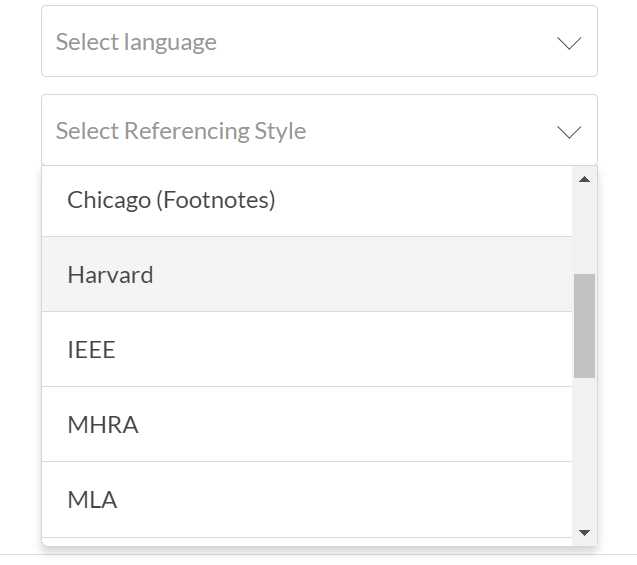Introducing AGLC Referencing
‘AGLC’ is short for Australian Guide to Legal Citation, a legal referencing guide published by the Melbourne University Law Review Association and the Melbourne Journal of International Law. Currently on its fourth edition, known as ‘AGLC4’, it is also the most widely used standard for legal referencing in Australia. So if you’re using this system in your writing, you’ll want an AGLC expert to check your work. And that’s where we come in.
AGLC Referencing Proofreading Services
Need to be sure your referencing is flawless? Then let our AGLC editing experts help. As part of our proofreading services, we will check all citations in your document, plus the bibliography, to make sure they are clear, complete, and consistent.
How To Select
AGLC Referencing
If you’d like us to use AGLC4 when checking your work, let us know when you upload your document. You can do this by selecting ‘AGLC’ from the dropdown menu.
And if you’re using an older version of AGLC, or if you have instructions for your editor, leave a note in the comment box here and we’ll adapt our process to match.

Instant Quote
Footnote Citations In AGLC Referencing
AGLC referencing uses superscript numbers to indicate citations. The first reference in a document would look like this, for example:
Several cases have tested this idea in the courts.¹
The number here will point to a footnote at the bottom of the page, which is where source information goes. For instance, we would cite a case report as follows:
¹ Smith v Jones (1982) 126 CLR 503, 522.
Here, we have the case name, the report year and volume, a report abbreviation, the first page of the report, and a pinpoint citation (i.e. the specific page cited). If we were then to cite the same source again, we would not repeat the full citation. Instead, we would either:
- Use ‘Ibid’ when citing the same text twice in a row (if we were citing a different part of the same text, we would also include a pinpoint citation)
- Cross reference the new citation with the original footnote by giving source title or author surname, followed by (n #) and a new pinpoint citation
So, repeat citations for the case above would look like this:
¹ Smith v Jones (1982) 126 CLR 503, 522.
² Ibid 517.
³ Navigation Act 2012 (Cth) s 14.
⁴ Smith v Jones (n 1) 508.
Here, footnotes 1, 2, and 4 are all citations of Smith v Jones. The ‘(n 1)’ in the fourth footnote shows us where to find the first citation of the source in question (i.e. footnote 1).
For more information on AGLC referencing, see our blog. You can also download the fourth edition of the Australian Guide to Legal Citation from the University of Melbourne website.
AGLC Bibliographies
You may also need a bibliography at the end of your document in AGLC. This is a list of every source used while writing your work. Typically, it would be divided into five sections:
- A. Articles, books, and reports
- B. Cases
- C. Legislation
- D. Treaties
- E. Other
Within each section, you should then list sources alphabetically by author surname or title (as applicable). You should also give full publication information in the bibliography. This is usually the same as in the first footnote, except:
- When a source has a named author, give their surname first
- You do not need a full stop at the end of bibliography entries
As with footnote citations, check our blog or the Australian Guide to Legal Citation for more information on how to format different source types in AGLC referencing.
Referencing Styles And Systems
Our expert editors can work with a range of referencing styles, including:
We can work with other referencing styles on request, too. Just let us know which system you’re using when you upload your work, and we’ll tailor our service accordingly. For more information on legal referencing styles, such as OSCOLA and AGLC, see our dedicated legal referencing page.




